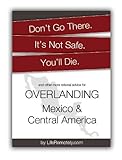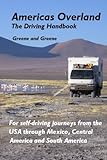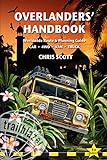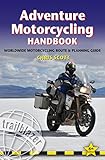Difference between revisions of "Chile"
Koen Devaere (Talk | contribs) m (extension rules) |
(Added point about new law) |
||
| Line 145: | Line 145: | ||
==Mandatory items in vehicle== | ==Mandatory items in vehicle== | ||
None. | None. | ||
| + | As of 2016 all vehicles are required to have a reflective vest on board for roadside repairs; | ||
==Roads== | ==Roads== | ||
Revision as of 11:17, 1 February 2016
Pan American Highway > Chile
Currency to display:
Contents
- 1 Visiting Chile
- 2 Entering Chile with a Car or Motorbike
- 3 Driving in Chile
- 4 Gas and Diesel price in Chile
- 5 Safety and Security Considerations
- 6 Camping in Chile
- 7 Navigation
- 8 Special Overland Travel interests
- 9 Vehicle Maintenance
- 10 Buy or sell a car or motorbike in Chile
- 11 References
- 12 Helpful External links
Visiting Chile
Chile is a very beautiful and safe country, and is very much enjoyed by Overlanders. The borders are easy, safety is not a concern and there is a lot to see and do. Distances are huge so expect to travel many miles. The amazing mountains of the south, where it can be very cold give you forests, amazing lakes, glaciers and active volcanoes. The middle is warmer with forest and wine plantations. The north is more like desert and dry and hot. Amazing beaches. The sea life is abundant and the salt lakes of Atacama are very picturesque.
Entering Chile with a Car or Motorbike
Correct as of: November 2013
Required Paperwork
(To check if you need a travel Visa for Chile, application instructions and fees see: Chile Visa online application at VisaHQ.com)
- Passport of registered owner (original)
- Vehicle registration (original)
- 17.10.1.1. Documentos que sirven de base para la confección del Título de Importación Temporal de Vehículos:
- a) Carné de residencia definitiva otorgado en el país extranjero o en su defecto contrato de trabajo vigente, en el que conste domicilio actual, visado por el cónsul chileno correspondiente.
- b) Pasaporte.
- c) Padrón del vehículo o documento que haga sus veces. En caso que el conductor no sea el propietario del vehículo, deberá presentar autorización notarial.
- d) Conocimiento de embarque, original en caso de vehículos llegados por vía marítima.
- 17.10.1.2. Confección del Título de Importación Temporal de Vehículos:
- Los interesados deberán señalar los siguientes datos:
- - Nombre del conductor.
- - Dirección estimada en Chile.
- - Nacionalidad.
- - Número de pasajeros.
- - Número del Pasaporte o, en su caso, cédula de identidad y país de emisión.
- - Descripción del vehículo y accesorios
- - Descripción del vehículo de arrastre, cuando proceda.
- - Firma del conductor.
- 17.10.1.3. Tramitación del Título de Importación Temporal de Vehículos
- La presentación del título se hará en la Aduana, avanzada o paso fronterizo ante la cual se solicitare el ingreso del vehículo al país, acompañada de los documentos que le sirven de base.
- De estar conforme la documentación presentada, la Aduana procederá a numerar y fechar el título, consignando la fecha de vencimiento del régimen de admisión temporal, de hasta noventa días, y entregar los ejemplares correspondientes al interesado.
- Con la numeración del título se entiende concedida la autorización para el ingreso temporal del vehículo al país.
Process at border
- The owner of the vehicle gains entry at Immigration (Migración), including a stamp in their Passport.
- The owner must show the new passport stamp and original vehicle registration to Customs (Aduana).
- The owner is issued a temporary import permit for the vehicle. Título de Importación Temporal de Vehículos
Mind you that if you cross from Argentina in the south of Chilli, you are not allowed to carry fresh meat , diary, even eggs. So consume them beforehand. You could hide them, but some border officials know where to look so better not take the chance.
Cost of entry
Free.
Permitted length of stay
The same as the owner, commonly 90 days.
Extension of stay
It is possible to extend your stay by visiting the aduana in Chile, or emailing them. But make sure that you extend it before the original permit runs out.
- PRÓRROGA DE TURISMO
- Autorización de carácter discrecional que se otorga a los extranjeros para permanecer en Chile, por período adicional de 90 días. Dicho trámite se realiza dentro de los últimos 30 días al vencimiento de la visa. El valor a pagar es de 100 dólares americanos (equivalente en moneda nacional)
Extension of TITV
17.10.1.4. Prórroga del Título de Importación Temporal de Vehículos
La prórroga del título deberá ser solicitada por el interesado, antes de la fecha de vencimiento, ante la Dirección Regional o Administración de la Aduana correspondiente, o ante cualquier Aduana debiendo acompañar el original de dicho documento, acreditar la prórroga de la Visa de Turista, mediante la presentación del correspondiente certificado emitido por la respectiva autoridad de Extranjería y Migración.
Si la solicitud se presentare en una Aduana distinta de la ingreso, ésta remitirá en forma interna la petición para su resolución.
En caso que la prórroga fuere concedida, se ingresará esta información al módulo de prórroga del sistema informático, y se entregará al interesado copia del documento.
Storing a vehicle and temporarily leaving the country
- In Chile it is possible to store a vehicle and to leave the country without it, as long as you are back before the permitted length of stay for car and owner runs out.
- In December 2015 Overlanders had this to say: We went today to the aduana office in the airport in Santiago. It took 5 minutes. Basically you just have to go there with the person who'll keep your vehicle. The officer asks for both your passports (or IDs) and fills out a form for you. I think you can do that on the day of your departure as it is super fast. Maybe they won't even check when we leave but we were not willing to take the risk! Also the aduana website says that the offices are only opened from 8:30 am to 2:00 pm. Upon return, we were able to have the paperwork canceled without our friend needing to return to the airport.
- In 2012, Overlanders did leave their vehicle in Chile for longer than the temporary import permit allowed. They say: We had to find someone in Chile who was prepared to sign to say they would keep the vehicle for us and we had to sign to say that if we did not return by the specified date the Chilean keeper of the vehicle would have the right to dispose of the vehicle as they wished - and all that had to go through the notary system first, signed by us and the person with a Chilean passport.
Exiting with a vehicle
- The registered owner presents the temporary import paper to customs.
- The registered owner is stamped out of Chile at immigration.
Driving in Chile
Recommended books for Overlanding in Chile
Travel insurance for Chile
World Nomads offer the most flexible Travel Insurance at the best prices for multi-country / multi-year trips. You can buy, extend and claim online, even after you've left home.
Vehicle insurance requirements
Insurance is mandatory in Chile, and Police will most likely ask to see it at some point. It's common to buy a policy that covers multiple countries in South America.
Cost of insurance
The mandatory insurance is called SOAP (Seguro Obligatorio de Accidentes Personales) and costs about $11,000.00 CLP per year for a Chilean car. Many insurance agencies will not sell SOAP to owners of vehicles registered outside of the Chilean national system, but it can be done with perseverance.
SOAP for a motorbike in Chile costs about $75.00 USD for a year (2014). The "insurance year" runs from end of March to end of March, so if you buy SOAP in February you can expect to pay the full year cost for less than 2 months of coverage.
Cheap insurance for foreign vehicles can be purchased online from Magallanes at http://www.magallanes.cl/venta/index.aspx?key=k66cl3. 5 months for a casa rodante for $10.00 USD.
For extended insurance, there is a Mercosur car insurance that covers most of the Mercosur countries. It costs $30.00 USD per month. It's the most basic type, covering only the car and people who are in a collision caused by the insured.
Where to purchase insurance
Online at http://www.magallanes.cl/venta/index.aspx?key=k66cl3. We purchased it at a Terpel petro station, which had a small insurance office attached. Falabella wouldn't sell insurance to foreigners when we tried in 2013.
Consorci sells SOAP online at http://www.consorcio.cl/soapex/APPS/Script/adquiera_soap.asp? They call it SOAPEX.
Driving license
Technically an International Driving Permit is required.
In reality, showing a license from anywhere in the world seems to be good enough.
Driving side of road
Right,
As recently as 2014, some Right hand drive vehicles have been denied entry, specifically at Southern border crossings and when shipping into Chile. Technically, this law is illegal, but a few overlanders have been denied entry, and there isn't really anything you can do. RHD vehicles proceed with caution.
In July 2014 one Overlander shipped into Southern Chile (Port Lirquen and the Customs at Talcahuano (Near Concepcion)) and had a nightmare of a time with paperwork to be permitted to drive a RHD vehicle. Eventually permission was granted, and he left Chile as soon as possible. Recent re-entries into the country have been no problem. The story is here:
You will remember the problems that I was having in Port Lirquen and the Customs at Talcahuano (Near Concepcion) who prevented me from collecting my car from the port, all because one official said that the right hand drive (RHD) was illegal in Chile.
I tried everything I could, but even after phone calls from friends and associates in Chile the customs (aduana) refused to allow me to bring my car into Argentina unless I got permission from the ministry of transport.
I went back and forth from the Ministry of Transport and even a letter was sent to the Ministers office in Santiago.
Eventually, I understood that the aduana were either just stupid or simply didn't care. I found out that the "law" that they referred to was not a law but a resolution, "Resolucion 36 of 15-7-1988. and that the actual law referring to my vehicle was Chile General Traffic Law November 2007. My vehicle and documents all complied with the 2007 law, but the aduana did not care or did not understand about the law or that I had a Carnet de Passage etc.
Eventually, the aduana agreed that I could collect my car if I collected from the port on the back of a truck (camion) and if I kept it off the road at my new friends private address, (thank goodness for the Land Rover Club de Chile)!! I had to sign a customs document that I didn't understand, as my Spanish is not good. (see attached). The aduana told me that I had to get permission from the Ministry of Transport and if that was granted then they would allow me to drive.
More phone calls were made to the aduana and the Ministry of Transport in Concepcion told me that it could take sometime. Days and weeks ticked by, but after another phone call to the head of the Aduana in Talcahuano, I was finally told that I could get permission if I returned with my documents. I returned and after sometime was told that they were sorry, but they couldn't issue me with the documents afterall and there was nothing they could do! I then realized something else, that the aduana there, really didn't know what they were doing.
I later spoke to the local police and had my documents checked and was told that all was correct, and I only needed my international driving license and that I should get insurance.
So, I made a decision to leave Chile as soon as possible. I obtained insurance from MAPFRE to cover me right across South America and the next day I drove from Santiago to the Argentina border.
I had no problems at the border and it was straightforward on the Argentina side. I drove south to Tierra del Fuego and again I had no problems entering Chile or Argentina again.
Mandatory items in vehicle
None. As of 2016 all vehicles are required to have a reflective vest on board for roadside repairs;
Roads
General Road quality
Roads in Chile are of excellent quality. All major highways are paved (although sections of the Carretera Austral are only gravelled), marked with lines and well signed. Local roads could be excellent too, however always watch for possible potholes which at times are not so infrequent in Los Lagos area. Watch for loose or herded domestic animals on the roads.
Road signs
Signs are very frequent and common, even on primitive roads.
Toll roads
The number of tolls from Santiago to Puerto Montt is about 10 on Ruta 5 (Panamericana). As of November 2013 a toll charge for a passenger car was $4.20 USD on most toll points. Farther south from Santiago the toll drops a bit to $4.00 USD, then $2.00 USD, and at Puerto Montt toll point it's $1.00 USD. Also, there are Exit tolls which are normally about $1.00 USD. Do not discard Ruta 5 toll receipt before you exit it; sometimes they will not charge toll for exiting because your Ruta 5 toll receipt could be accepted as payment as you may not have driven a long distance from the previous Ruta 5 toll. Try to have always exact change.
In Santiago, the toll roads are much faster. Traffic is quite awful. Here is how to pay for the toll roads:
1) Day passes - Use the roads, then pay later. Payment within 3 days of usage is cheaper. Not sure where to pay though, Copec perhaps - anyone to add? - Buy a day pass at the gas station, Copec, then use the roads. It costs roughly $5,000.00 CLP to $6,000.00 CLP per day. - See more here from the official guys.
2) Tag (electronic beeper) - not sure if this works for non-Chilean cars - Buy a tag at one of the offices. There is one in the metro underground area of estacion Universidad de Chile. For a Chilean car, they needed our RUT and passport only. - It's cheaper than the day passes, but quite a bit of hassle to get it. Get it if you will drive around Santiago for many days. - See more here from the official guys.
Vehicle Ferries
Naviera Austral operates ferries from Caleta La Arenas across the Reloncavi Strait and continue on the Carretera Austral. The first ferry is at 07:15 and then every 45 minutes from then on. They have a helpful office in Puerto Montt [1]. A ferry transfer from mainland to Chiloé Island or back costs 10500 pesos (21 USD) one way. You pay the fee on the ferry upon entering. You cannot pay for a round trip. The crossing takes some 30 min.
Bribery in Chile
Bribery is not common in Chile, though it does happen. Do not assume a Police officer is trying to bribe you, as he may take offense, making the situation worse.
See the bribery tips page for advice.
Checkpoints
There are no Check Points (at least between Santiago and Chiloé) where the police stop you just to check your papers. There are control stations, traffic random monitoring points or road patrols. Carabineros de Chile control stations do not happen as often as toll points. There are advance sings on the right side of the road warning that the Carabineros control station will be in 500 meters. In the middle of the road there will be a shield shaped sign with two crossed rifles on green backdrop. On those control points there could be a police car with a speed radar. Normally, carabineros do not hide to radar you but once I did see a green police car right behind the hill top. Carabineros control stations at local roads are rare but highway patrols can be seen here and there. While cruising, the police vehicles have their roof top red lights flashing but this is just to let you know they are there, it’s not that they are on an emergency call.
Traveling with pets
In all national parks pets are not allowed. You can still try to drive through without being caught depending what park it is, but officially it's not allowed. Private parks like the Huilo-Huilo or the Pumalin Park from Douglas Tomkins allow pets.
Otherwise traveling in Chile with pets is easy. There are good veterinarians and you get high quality food but not cheap.
Problematic is the border procedure when entering from a foreign country into Chile. You will need a health certificate and a SENASA certificate to enter Chile. For Chile it's officially only valid 21days after issue but sometimes they also accept older SENASA certificates.
People attitude towards dogs and their owners are alike in Europe or USA. It's expected that you pick after them etc.
Be also aware that dog food is usually only allowed in still sealed bags and with no bone contents. Check ingredients and leave bag sealed before crossing the border to Chile. Some borders will let you through with open bags, some not.
More information can be found here
Gas and Diesel price in Chile
Last updated: July 2015
Currency and unit to display:
| Gasoline Grade | Price |
|---|---|
| Regular - 93 octane | $740.00 CLP per Liter |
| Super - 95 octane | $780.00 CLP per Liter |
| Premium - 97 octane | $800.00 CLP per Liter |
| Diesel Ultra | $540.00 CLP per Liter |
Gas and Diesel Availability / Frequency
Gasoline shortages are not common, and gas stations are frequent, except in the extreme South and North of the country. Here (for example in Aisen and Patagonia) gas stations are sufficient for journeys but it is advised to fill up if you pass a gas station and you have under half a tank remaining.
Gas and Diesel Quality
Gasoline and Diesel are generally thought of as high quality, and very high octane gasoline for performance cars is usually available. Diesel Ultra from Copec stations has 15ppm sulfur content. More info on the Copec site: http://ww2.copec.cl/combustibles/products/diesel-ultra
Gas and Diesel App
This app on the phone lets you show all the cheap gas stations in Chile. http://www.bencinaenlinea.cl
Safety and Security Considerations
Driving at night
Driving at night is not typically thought of as a problem.
Vehicle parking
Parking vehicles on the street towns during the day and at night is typically OK. Find a secure parking lot in the biggest cities, especially in Puerto Montt and Valparaiso.
Special driving considerations
Headlights must be on all time.
Security advisories and information
- Country Specific Information - U.S. Department of State
- Travel Reports and Warnings - Foreign Affairs and International Trade Canada
- Travel advice by country - Foreign and Commonwealth office (U.K.)
- Travel Advice for Chile - Australian Department of Foreign Affairs and Trade
Camping in Chile
Camping is becomming more common in Chile, and as such campgrounds can usually be found in touristy areas. Many Overlanders road-side camp in the remote parts of Chile.
Price for organized campsites is Unknown.
In Santiago, the Hostel International on 151 Cienfuegos, centrally located near metro station Los Heroes, has a big parking lot with no height or width issues for most overlanding vehicles.
Bloggers often publish camping lists - see section below.
Camping guide books
Unknown.
List and link to books specifically for camping.
Drinking water
Tap water in almost all of Chile is safe to drink. Ask a local to be certain.
Paper maps
Reise Know-How are amoung the best paper maps. Purchase paper maps before arriving in Chile
Very high quality road maps of Chile can be purchased in gas stations and book stores throughout the country.
GPS Maps of Chile
- Open Street Map: Appears to have good coverage.[2]
- Garmin: "Most urban areas with intertown roads".[3]
- TomTom: Amount of coverage not listed. [4]
- Proyecto Mapear has great coverage and version 10.0 also includes Argentina, Uruguay, Bolivia and Paraguay [5]
GPS co-ordinates for camping, propane, gas, repairs, etc. in Chile
- iOverlander is a website and iPhone application designed by Overlanders, for Overlanders. It contains GPS co-ordinates and reviews for camping, hotels, propane, water, mechanics, borders and much more.
- Places in Chile - Camping Places, Food & Sights in Chile from Pawsontour. In German only
- Camping Sites: Chile North,Camping Sites: Chile South - Detailed list of campsites and propane filling with description, directions and GPS co-ordinates. Some at hotels (lists facilities and price), some roadside and free.
- Andes Expedition camping Locations - List of campsites, with basic directions and GPS co-ordinates. Mostly free sites.
- Camping Log 2: South America - List of campsites, shopping, fuel, propane and border crossings with excellent descriptions and GPS co-ordinates.
- Hackney Travel SA Waypoints - Raw GPS data (in gdb or gpx format) for waypoints (including campsites, fuel, repairs, propane and more).
- The Silk Road Motocaravan Network - Raw GPS data for waypoints (camping, gas, propane, points of interest and more).
- Landcruising Adventure – More than 50 GPS Waypoints of Accommodation, Campsites & Rough Camps.
- Seventeen by Six - coordinates, directions, and reviews of their camping sites in Chile.
Special Overland Travel interests
- The extreme southern end of the Carretera Austral (Route 7) is highly regarded among Overlanders and well worth the drive. The road is a dead end at Villa O’Higgins, the extreme Southern end. It is possible to buy extremely expensive gas here, but don't count on it being there. It's necessary to catch a ferry to get all the way to the end, these ferries run year-round.
Vehicle Maintenance
Dealers
4x4s / Trucks
- Toyota Global Dealer Locator
- Land Rover International Dealer Locator
- Mercedes Benz International (select country on bottom right)
- Jeep International site locator
Motorbikes
Local Garages
- Arica, Chile Centro Diesel Turbo, La Africana 3262, Phone 2215740 Owner Flavio and mechanic Jonathon are top notch. Approx GPS coords: -18.459701, -70.283936
- In Limache (1 hour from Valparaiso) there is a reliable, good mechanic and speaks some English. His name is Jano and his cell phone is+56 9 7744 6162
- Monster 4x4 - Their store was well stocked with good parts and the gents there seemed great
Buy or sell a car or motorbike in Chile
Buy
Foreigners can purchase and register vehicles in Chile, and drive them to any country they choose without limits. However, foreigners (nonresidents) must first obtain a tax identification number called a RUT in order to register a vehicle which has proven problematic in 2015.
- An easy to follow how-to guide of the purchase process is available to read at http://practicingforretirement.com/index.php/buy-a-car-in-chile/
- Here is a write-up of how Overlanders did it in early 2015 http://www.whereswaller.com/#!2015-buy-a-car-in-chile/c1kma.
Spencer Global (http://www.spencerglobal.com) is a law firm run by an American in Chile. For a fee ($250,000.00 CLP in mid 2015) they will obtain your RUT as your Power of Attorney, and represent you for tax purposes in Chile for a year. You can apply for a RUT before you even arrive in the country. A thread with more details is here http://www.allchile.net/chileforum/viewtopic.php?f=11&t=12862&sid=a31e0fb0868f6647c7d63e7c47d45ef0
Here is a blog entry giving advice about buying a vehicle in Chile in 2013 to drive North. http://kiwi-panamericana.weebly.com/adviceinfo/buying-a-car-in-chile
Sell
The process is long and difficult, but it can be done.
A few things to note:
- If you have a camper or any type of vehicle you can sleep in, when you enter Chile try to get the vehicle type listed as "Camper" on the temporary import papers. This will make it much easier to sell, legally, anywhere in the country.
- Chile has special "Tax Free Zones" (Zona Franca) (Region XII) (Puerto Natales* is a good example) that have different importation laws that the rest of the country. A resident of those zones can legally import a vehicle that is less than 10 years old, though they will have to use a customs agent, deal with a lot of paperwork, pay heavy taxes and fees and the vehicle will be restricted in where in can go within Chile. You will need to find a resident of one of the tax free zones willing to go through the paperwork and expense and sell your vehicle to them. Due to the cost and difficulty, do not expect to receive a large amount for your vehicle.[6] Some people claim to be able to get around the not more than 10 years old rule. If you are a tourist (nonresident of Chile), the effort involved in selling a vehicle to someone in a Zona Franca region can be enormous and frustrating.
- To advertise your vehicle for sale, try http://mercadolibre.cl or http://vivastreet.cl
- A recommended dealer is Kunstmann in Rancagua, Ruta 5, km 99 - website http://rodantes.cl/
References
- ↑ Naviera Austral
- ↑ OpenStreetMap Chile
- ↑ City Navigator® South America NT
- ↑ TomTom Map availability
- ↑ Proyecto Mapear
- ↑ Chile Forum - Can I sell my Canadian car in a Zona Franca?
Helpful External links
- Landcruising Adventure – Travel Information Page on Chile (paperwork, border crossings, money matter,s budget, documentation, diesel & gas stations, etc).
- Self Drive in Chile – Sample itineraries for overland travel in Chile
- Chile: Visa and Passport requirements | World Travel Guide
- Health Information for Travelers to Chile - Center for Disease Control and Prevention
- Chile travel guides at wikivoyage
- Chile - Wikipedia, the free encyclopedia








